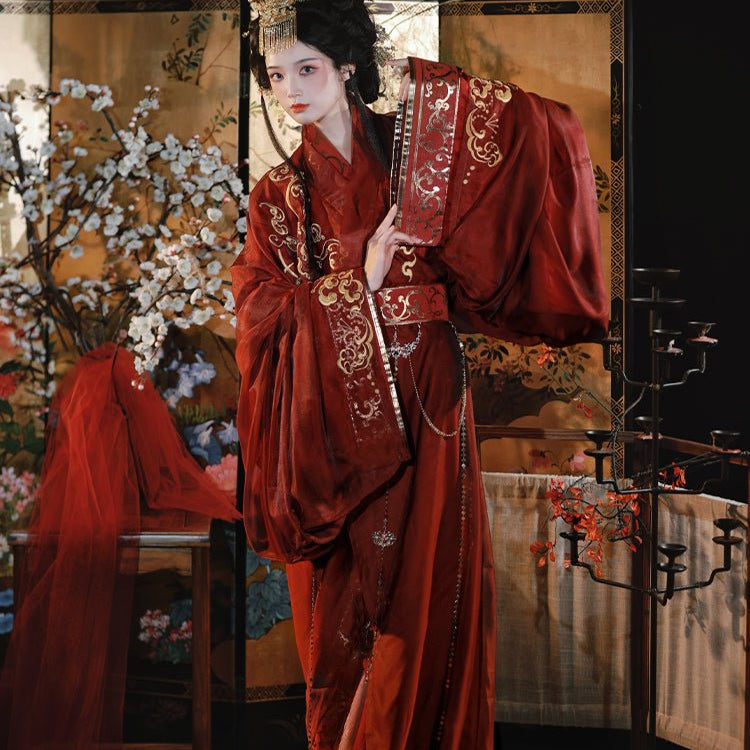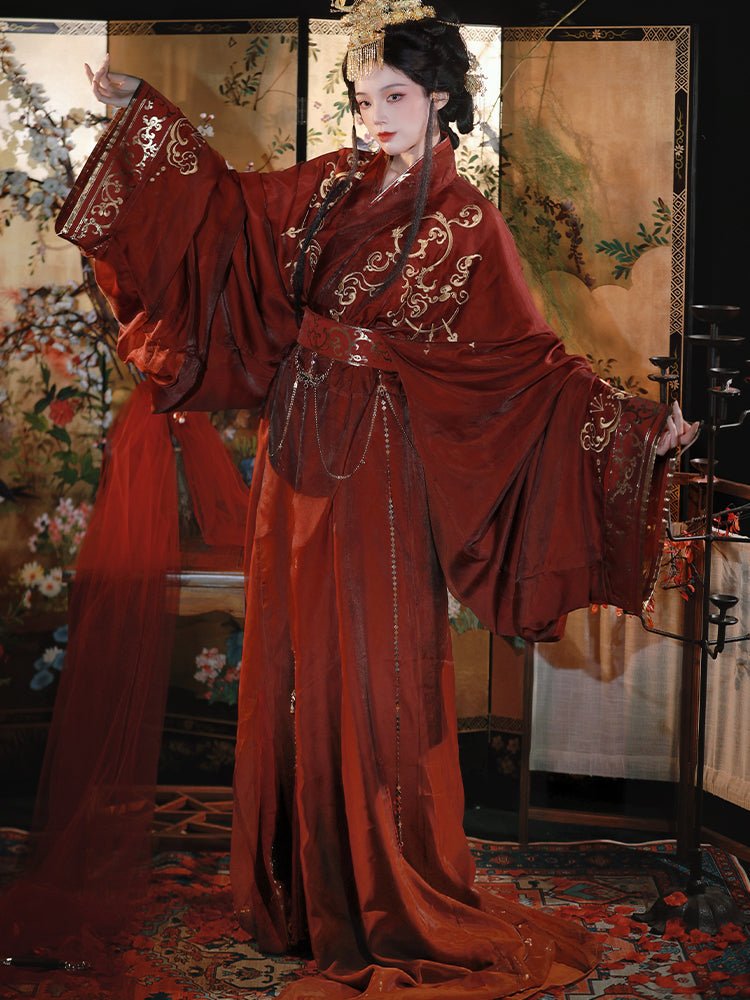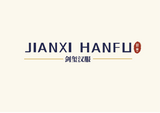This Qin Han Dynasties "Fate" Zhiju robe (straight robe) traces its design deeply back to the robe styles of the Warring States period. The set consists of an outer robe, an inner robe, a waist belt, and a waist chain. The outer robe is crafted from gauze fabric, with exquisite golden embroidery patterns adorning the chest and cuffs, looking light and elegant. The inner Zhiju robe uses high-end printed fabric, with subtle patterns of bamboo leaves and birds faintly visible. The neckline and cuffs are trimmed with matching golden edgings, which complement the bright red robe body, exuding a timeless ancient charm while showcasing ingenious details. When paired with the waist belt in the same pattern and a specially-made waist chain, the layered tailoring of the Zhiju robe not only conveys a solemn and dignified aura, but also injects a playful and lively touch into the whole through the gold-speckled and bright-colored trims. It truly combines dignity, elegance, and agility in one.
Notice:
1.This is a custom - made style. It will be dispatched 7 weeks after the order is placed. If you have any questions, please contact us.
2.The set includes: an outer zhiju robe + an inner zhiju robe + a Waist Belt + a Waist Chain.
Please note that the pattern print is not fixed, the position will be random and differ from the product images.
-
Warring States Shenyi (Source)
Represented by the No.15 Brocade Robe (Mashan Chu Tomb, Jiangling, Hubei), it featured a cross-collar with right overlap and Quju wrapping (forming triangular "extended lapel hooks"). Made by joining separate upper/lower parts, it was full-coverage but impractical for movement—only for rituals.
-
Qin-Han Robe Differentiation
-
Quju robes (Early Western Han mainstream): Inherited wrap-around design (e.g., Scarlet Rhombus-patterned Gauze Robe, Mawangdui Tomb) with flared hems. Worn in 3 layers (outer curved, middle straight, inner unlined) as noble ceremonial attire.
-
Zhiju robes (Eastern Han mainstream): Vertically cut (e.g., Plain Gauze Robe, Mawangdui Tomb). Popularized after crotch trousers spread (no need to cover lower body), becoming daily wear for officials/commoners and even court attire.
-
Tech & Materials
-
Silk: Mawangdui’s Plain Gauze Robe weighed 49g (12g/sq.m), with silk 30% finer than modern silkworms. Brocades used "four-harness warp weave" (e.g., geometric pile brocade)—exclusive to nobles.
-
Linen: Mawangdui linen had 37 threads/cm (near modern fine linen). Zhou’s ban on "trading embroidered silks" was lifted; merchants/servants could wear trimmed silk shoes.
-
Class-Based Attire
- Nobles: Lady Xin Zhui’s (Mawangdui) Scarlet Rhombus-patterned Robe (cinnabar-dyed, pile brocade trim).
- Qin soldiers: Short Zhiju robes (under armor)—balanced ritual and practicality.
-
Cultural Marker
The Book of Rites emphasized "right-overlap = orthodox"; Han Dynasty saw left-overlap collars as "barbarian" (Xiongnu, Xianbei). Evidence (Mawangdui figurines, Qin terracotta) confirms right-overlap as core of Huaxia attire.
-
Straight-Lapel Popularity Logic
It reflected a shift from "ritual priority" to "practicality": With crotch trousers, straight-lapel robes suited daily use—officials wore black-trimmed court versions, commoners wore short-lapel styles, covering "court to marketplace".
Qin-Han robes combined form differentiation (Quju-curved for ritual, Zhiju-straight for convenience), fabric stratification (silk/brocade for nobles, linen for commoners), and symbol unification (right-overlap collars). They turned Warring States’ ritual "shenyi" into universal attire—from Mawangdui’s gauze robes to Eastern Han stone-carved "Chanyu court robes", embodying "governing via ritual attire" and becoming a core Chinese clothing gene.
A Sanctuary for 1.8 Million Hanfu Devotees
Featured Products: Breathing New Life into Ancient Elegance with Original Designs
Spanning from Warring States Period Quju robes to Han Dynasty Ruqun sets, Tang Dynasty Pibo (long silk scarves) to Song Dynasty Beizi jackets — we blend archaic restorations and innovative fusions. Must-have lines include:
- The starry “Canglan” Quju (renowned for gold-speckled fabric and authentic Warring States tailoring).
- The elegant “Hongyan” Han-style Gown (adorned with intricate cloud embroidery).
- The bestselling “Autumn Twilight” Jin-style Set — perfect for traditional rites, cultural shows, or immersive Hanfu events.
We use premium fabrics (silk brocade, linen-jacquard blends) and meticulous tailoring to recreate ancient grandeur:
- Winter styles use weighted satin for stately drape.
- Spring collections opt for breathable silk-cotton — comfy yet regal.
70% of products range $68–$158 — balancing opulence and affordability:
- A Warring States Quju set (with hand-finished edges) is ~$128.
- A Han Dynasty Ruqun (with embroidered collars) costs $98 — an investment in timeless culture.
We prioritize hand-embroidery (see the “Hongyan” gown’s delicate clouds) and natural plant dyeing (for rich, lasting hues). Customer reviews rave: “Museum-level detailing!”
- Boasts a 4.8-star rating with 20,000+ 5-star reviews.
- Ranks top 3 in premium Hanfu monthly sales (2025).
- The “Canglan” Quju sells 800+ pieces monthly — proof that true Hanfu lovers trust our quality.
- “The ‘Canglan’ Quju is stunning — gold specks shimmer like stars, and the fabric feels luxurious. I wore it to a gathering and got endless compliments!”
- “Craftsmanship is insane! The ‘Hongyan’ gown’s embroidery is so precise — it’s a work of art. Worth every penny.”
- “Finally, a brand that nails ancient styles! Their Warring States robe makes me feel transported, yet it’s comfy enough to wear all day.”
Here, tradition is reborn as tangible cultural romance. Whether you’re a collector seeking museum-worthy replicas or an enthusiast craving authentic ancient vibes, our “craft-first” approach ensures Hanfu is more than clothing — it’s a bridge to centuries of history. With 1.8 million fans and a 4.8-star legacy, isn’t it time to own a piece of timeless beauty?











